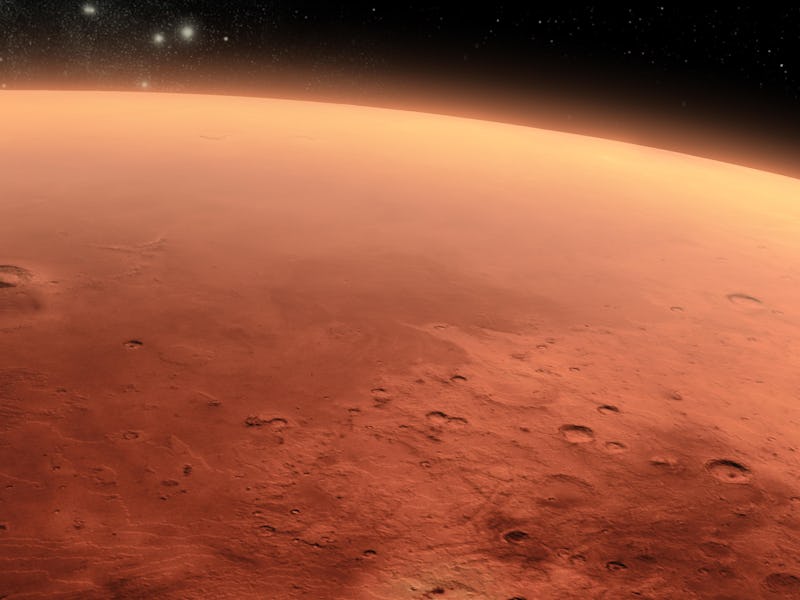How What We Think of Mars Has Changed Since Mariner 4
It's a fitting day for a fiftieth anniversary.

It feels right that today be #pluto day because it also happens to be the 50th anniversary of the day that Mariner 4 captured the first satellite imagery of the closest planet in our solar system, Mars.
Mars has been an object of wonder for humans ever since we started looking up into space and naming the bits of lights that keep looking all too familiar. But for nearly 4,000 years, the red planet was just a little dot in the night sky that that most people spun imaginative tales and hypotheses about, while a small contingent of astronomers around the world
In fact, the 50-year history of mankind’s intimate relationship with Mars reads like a romance. Here’s how far we’ve come.
The Sixties
The Soviet Union kicked off Mars exploration. Or at least it tried to. Throughout the ‘60s, the Soviets launched unmanned probe after unmanned probe — some nine total — without any meaningful result. Some probes failed to clear Earth’s orbit, others burned up, and three simply exploded.
NASA’s primary focus at the time was in putting a man on the moon, and this overshadowed everything. Yet the Mariner missions still found some success. Mariner 4 managed to take the first-ever close-up image of Mars in 1965.
Mariner 4's close-up image of Mars.
Yet the Mariner Mars 1969 Project managed to send the Mariner 6 and 7 spacecrafts on a fly-by of the red planet between July 31 and August 5, 1969. Both spacecraft managed to collect quite a bit of imaging data and scan the planets heavily cratered terrain.
That same year, NASA also established the International Planetary Patrol Program, lashing nine different observatories around the world together into a data-collection network devoted to detailing large-scale atmospheric and surface features of the other planets of the solar system.
The Seventies
The U.S. got out ahead in the Space Race and maintained its lead. The Soviet M-71 probe failed to launch in 1971 as NASA’s Mars 2 and 3 successfully launched, reaching Mars seven months later. But success was by no mean absolute: Mars 2 crashed onto the planet (earning the distinction of being the first man-made object to reach the surface). Mars 3 successfully lands, however, and both orbiters transmitted back meaninful data and imagery.
The Soviets launched four more spacecraft in the “Mars” series before the decade was out, but only met success with Mars 5, which managed to collect and transmit data for just a few days.
Viking 1 landing site.
Both spacecraft were sent to collect data on the geological and atmospheric features of Mars, but the most exciting prospect was finding signs of life. At the time, there was nothing to suggest life existed or had ever existed.
Viking 2 landing site
The Eighties
This decade was pretty quiet. The Soviet Union made two attempts to reach the Martian moon of Phobos in ‘88 and ‘89, but both ended in failure.
The Nineties
The ‘90s were a fantastic time for Mars exploration that really set a new tone for how we see the red planet. After losing the Mars Observer spacecraft in 1993, NASA came back with the Mars Global Surveyor in 1997, and collected tons more images from high above Mars’ orbit.
Gullies on Mars, snapped by the MGS
The MGS managed to take a new pic of the infamous “Face On Mars” image that showed the original 1976 image really just suffered from bad lighting and low resolution.
The Pathfinder lander and Sojourner rover also arrived on Mars in 1997. The former was only expected to last a month, and the latter a week, but both managed to make it for at least several months before contact was lost.
The Pathfinder lander
The New Century
The new century began with an amazing image of dust storms on Mars taken by the Hubble Space Telescope in 2001, the same year that saw the Mars Odyssey successfully land on the planet’s surface.
Dust storms on Mars.
Currently, however, it’s the Curiosity rover that’s in the spotlight. The little robot landed on Mars in 2011, and has been trudging along the landscape gathering data on the climate, geology, and chemical processes of the planet ever since.
The Arctic surface of Mars, as seen by the Phoenix lander.
Though Curiosity’s work is followed by millions of people around the world — scientists and nonscientists alike — its legacy is simply the culmination of decades of work by NASA to give people a much clearer view of what Mars really looks like. Our vision of the planet has never been sharper, even if we’ve yet to set foot on it and see it for ourselves.
A self-portrait of the curiosity rover.